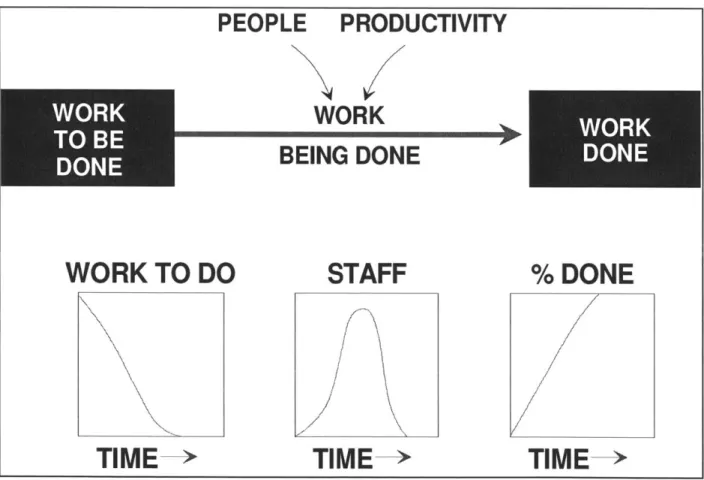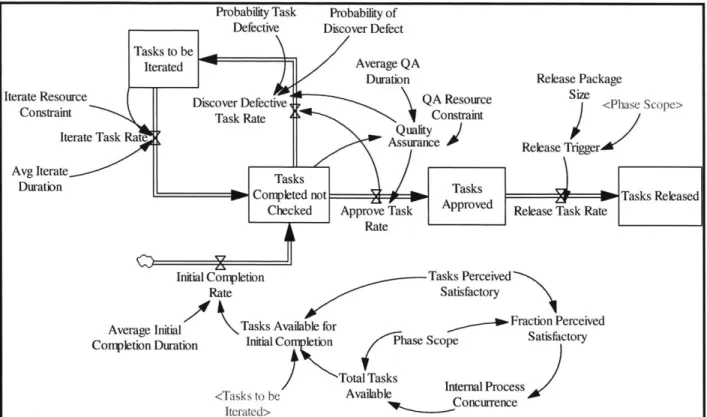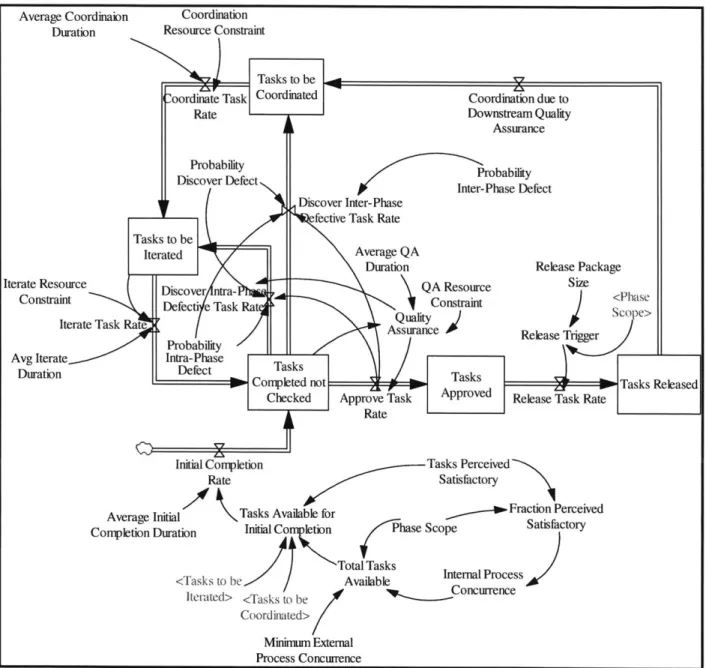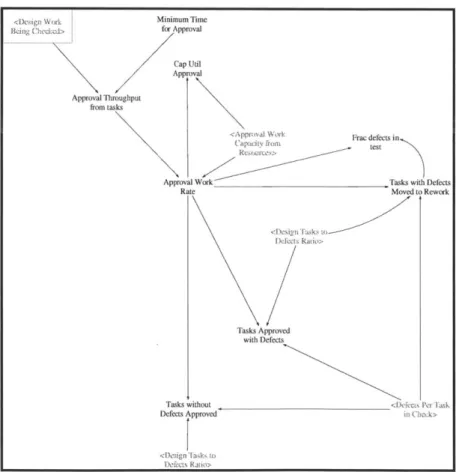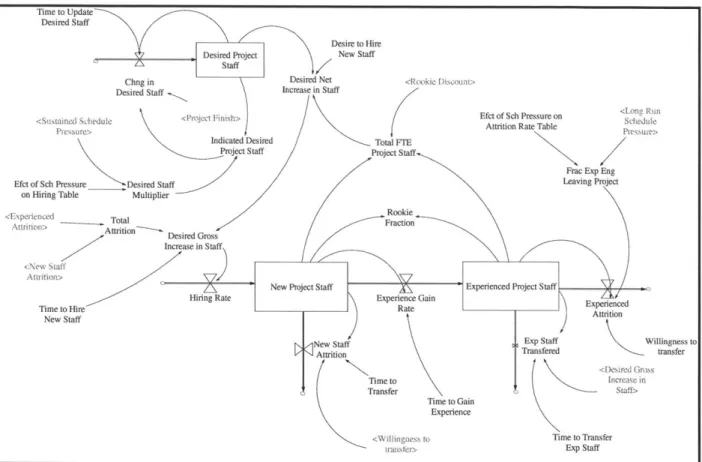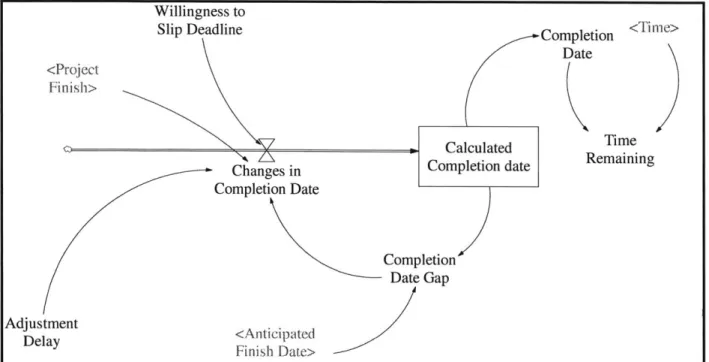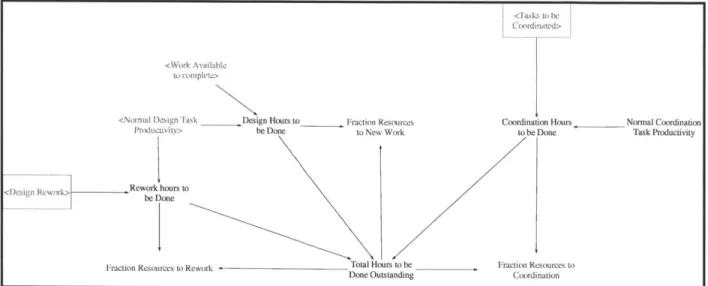Development of a System Dynamics Based Management Flight
Simulator for New Product Development
by
Daniel V. Maclnnis M.S. Aerospace Engineering (1986)
University of Maryland B.S. Aerospace Engineering (1986)
United States Naval Academy
Submitted to the System Design and Management Program in Partial Fulfillment of the Requirements for the Degree of
Master of Science in Engineering and Management
at the
Massachusetts Institute of Technology February 2004
0 2004 Massachusetts Institute of Technolo y
All rights reserved Signature of Author
Daniel V. Maclnnis System Design and Management Program
A
)
a , February 2,004Certified by
J. Spencer Standish Associate
Accepted by Howard W. Johnson Nelson P. Repenning Professor of Nanagement Thesis Supervisor N'Thoinas J. Allen Co-Director, LFM/SDM Professor of Management Accepted by MASSACHUSETTS INSTiTUTE OF TECHNOLOGY
FEB 1 12004
David Simchi-Levi Co-Director, LFM/SDM Professor of Engineering SystemsDevelopment of a System Dynamics Based Management Flight
Simulator for New Product Development
by
Daniel V. Maclnnis
Submitted to the System Design and Management Program on January 12, 2004 in Partial Fulfillment of the Requirements for the Degree of Master of Science in Engineering
and Management
Abstract
All firms in any mature product development industry are being pressured into
performing 'better, faster, and cheaper' by both customers and competitors. In short, firms are being tasked with doing more, with less, faster. This leads to product development organizations being unrealistically tasked to deliver on these programs that often lead to projects falling behind schedule, over budget, and with inadequate quality. While striving to do the right actions to survive, the management of these firms may be leading their firms to disaster through over commitment, and short-term management actions to address the quality, budget, and schedule shortfalls.
An understanding of the system dynamics associated with the program management of new product development (NPD) programs is essential to reversing this trend. Several
corporations are instituting system dynamics in their management and executive training curricula to affect correct policies, procedures, and behaviors that lead to success. However, because the correct policies, procedures, and behaviors as revealed by system dynamics analysis are counter-intuitive and opposite those policies currently employed in program management, a method is needed to drive the learning of system dynamics so that it becomes ingrained in the program management thought processes. A management flight simulator (MFS) of the program management of a new product development project based on system dynamics provides the hands on experience that managers can learn the consequences of non systems-thinking policies on project performance and how system dynamics based policies can lead to greater success.
This thesis provides an overview of the system dynamics of project management in new product development and insight into the correct policies, procedures, and behaviors that lead to success. Research on the role of MFSs in driving the learning of system dynamics principles is explored. A single-phase system dynamics model for a new product development program and a
MFS is developed to teach the fundamental lessons of system dynamics applied to product
development project management and is to be incorporated in the BP Project Academy. Insight from my own experiences in product development is incorporated in this MFS as well as in recommendations for further development.
Acknowledgements
I would like to thank my thesis advisor, Nelson Repenning, for his tremendous support in
this thesis, help in developing the system dynamics model and management flight simulator, and expertise on project dynamics. It was his lecture on 'Tipping' and fire-fighting in new product development that motivated me to do a thesis on system dynamics in NPD.
I would also like to thank Nick McKenna, a fellow SDM student who with Nelson
developed the system dynamics model for which this MFS is based on. I would also like to thank Scott Johnson of the BP Project Academy who provided the funding for the development of this MFS and for his guidance on the requirements of the MFS for incorporation into the BP Project Academy training curriculum. Many thanks also goes to the MIT Sloan School
Management Science faculty and PhD candidates who 'flight tested' the MFS and provided valuable feedback for refinement of the MFS.
I also would like to thank James Lyneis, John Sterman, Brad Morrison, Jay Forrester, and
Peter Senge who through my SDM studies introduced me to the exciting field of System
Dynamics. I now and forever will see things in a different light and as John Sterman told me, it is clear that I am 'looped for life.' I plan to continue my involvement in System Dynamics at my new position at Raytheon Missile Systems and through the System Dynamics Society.
Finally, my deepest thanks go to my wife, JoAnne and my daughter Danielle who provided love, support, and understanding throughout my studies at MIT
Table of Contents
Chapter
Page
ABSTRACT ... 3
ACKNOW LEDGEM ENTS ... 5
TABLE OF CONTENTS ... 7
LIST OF FIGURES... 10
LIST OF TABLES ... 14
1. INTRODUCTION ... 16
1.1 Background and Motivation...16
1.2 O bjectives ... 19
1.3 . A p p ro a ch ... 2 1 1.3 .1 M eth od ology ... 2 1 1.3.2 Structu re of T hesis...22
2. SETTING ... 26
2.1 System D ynam ics ... 26
2.2 Product Development Process ... 31
2.3 B P P roject A cadem y ... 34
3. LITERATURE REVIEW ... 36
3.1 System Dynamics and New Product Development ... 36
3.1.1 Problems of New Product Development Projects ... 36
3.1.2 Dynamic Perspective on the Problems of New Product Development Projects ... 41
3.1.3. The Rework Cycle, Feedback Effects, and "Knock-On" Effect ... 46
3.1.4. Process Concurrence and the Ford-Sterman Model... 55
3.1.5. Fire-Fighting and Project "Tipping" in New Product Development... 60
3.2 The Role of Simulation in Improving Organizational Learning ... 61
4. M ETHODS...66
4.1 System Dynamic Model of Single-Phase, Single Project NPD Project...66
4.1.1. W ork Flow Structure...67
4.1.2. Defect Flow Structure...70
4.1.3. Staffing Structure ... 73
4.1.4. Completion Date Structure ... 76
4.1.5. C ost S tru ctu re ... 77
4.1.6. Resource Allocation to W ork Flow and Productivity Structure... 79
4.1.7. Schedule Pressure Structure... 83
4.1.8. Earned Value Management System Reporting Structure'... 87
4.1.9. Modeling Feedback Effects on Productivity and Quality... 91
4.2 Development of Management Flight Simulator (MFS) for New Product Development (NPD)...99
4.2.1. Principles and Requirements of BP NPD MFS Learning System ... 99
4.2.2. Requirements for the MFS... 104
4.2.3. Architecture of the MFS... 104
5. RESULTS... 123
5.1 NPD Project Dynamics... 123
5.2 Results from "Flight Testing" the MFS...127
6 . D I ... 13 2 6.1 Lessons to be Learned by Playing the MFS ... 132
6.1.1. Ensure a Realistic and Attainable Schedule... 132
6.1.2. Intuitive Management Actions can Exacerbate Undesirable Project Dynamics...134
6.1.3. Other Lessons for Understanding Project Dynamics ... 136
6.2 Insights from the Role of the MFS in the Learning Process ... 137
7. FUTURE W ORK ... 140
7.1 Future Development of NPD System Dynamics Models ... 140
7.1.1. Self-imposed Schedule Pressure ... 140
7.1.2. Modeling Schedule Pressure Management Actions ... 142
7.2 Future Development of NPD Management Flight Simulators... 143
8. CONCLUSIONS AND RECOM M ENDATIONS... 147
8.1 The Problem in New Product Development Project Management ... 147
8.2 The Rework Cycle and Process Concurrence Models... 147
8.3 The Role of Management Flight Simulators ... 148
8.4 The Project M anagement Lessons Learned from NPD MFS ... 149
8.5 R ecom m endations...150
REFERENCES ... 152
APPENIX A EQUATION LISTING OF BP NPD MFS MODEL ... 155
List of Figures
Figure
Page
Figure 1. Causal Loop Diagram (CLD) of Production System, adapted from (Sterman, 2000, p. 14 9 ) ... 2 9
Figure 2. Stock Flow Structure of New Product Adoption ... 30
Figure 3. BP Project Academy Plan, taken from (Johnson, 2003)...34
Figure 4. Business Capture Causal Loop Diagram - Relationship Between Business Goals, Bid/Planning, Resource Demands, and Customer Satisfaction (taken from Al McQuarrie 2003 M IT SD M T hesis)...38
Figure 5. Typical Staffing Behavior Patterns for Projects (adapted from ESD.36J Course Lecture Notes from James Lyneis and in literature (Reichfelt and Lyneis, 1999))...42
Figure 6. Typical Project Completion Behavior Patterns for Projects (adapted from ESD.36J Course Lecture Notes from James Lyneis and in literature (Reichfelt and Lyneis, 1999)) ... 43
Figure 7. Typical Productivity Behavior Patterns for Projects (adapted from ESD.36J Course Lecture Notes from James Lyneis and in literature (Reichfelt and Lyneis, 1999))...45
Figure 8. Traditional Project Management Work Accomplishment Stock Flow Structure (taken from ESD.36J Course Lecture Notes from James Lyneis (Lyneis, 2002)) ... 47
Figure 9. Traditional Project Management Work Accomplishment Stock Flow Structure (taken from ESD.36J Course Lecture Notes from James Lyneis (Lyneis, 2002)) ... 48
Figure 10. Rework Cycle with Feedback Effects on Productivity and Quality (taken from ESD.36J Course Lecture Notes from James Lyneis (Lyneis, 2002))...49
Figure 11. Rework Cycle Representation of Multi-Phase Product Development Project to Represent "Knock-On" Effect (taken from ESD.36J Course Lecture Notes from James L yneis (L yneis, 2002))...52
Figure 12. New Product Development Process Structure for a Single Project Phase (adapted from Ford and Sterm an, 1998). ... 57
Figure 13. New Product Development Multi-Phase Process and Coordination Structures (adapted from Ford and Sterm an, 1998)... 59
Figure 14. Work Flow Structure of BP NPD MFS Model...67
Figure 15. Internal Concurrence Relationship Table Function ... 68
Figure 16. Defect Flow Structure of BP NPD MFS Model ... 70
Figure 17. Approved Task Defect and Tasks with Defects Moved to Rework Definition R elation sh ip s...7 2 Figure 18. Staffing Structure of BP NPD MFS Model ... 74
Figure 19. Staffing Estimate Definition of BP NPD MFS Model...76
Figure 20. Completion Date Structure of the BP NPD MFS Model...77
Figure 21. Cost Structure of BP NPD MFS Model...78
Figure 22. New Work, Rework, and Coordination Resource Allocation Structure...80
Figure 23. Approval W ork Capacity Structure ... 80
Figure 24. Resource Capacity for Rework, New Work, and Coordination Structure...81
Figure 25 O vertim e Structure... 81
Figure 26. Table Function to Increase Overtime as Sustained Schedule Function Increases ... 82
Figure 27. Design, Approval, and Coordination Task Productivity...83
Figure 28. Schedule Pressure Structure of BP NPD MFS Model...84
Figure 29. Structure to Determine Anticipated Completion Date...85
Figure 31. Additional Schedule Pressure Definition...86
Figure 32. Scheduled Work Completed Structure...87
Figure 33. Example of SPI vs. SPI "Bulls-Eye" Chart Used in EVMS ... 90
Figure 34. SPI and CPI Definition in BP NPD FMS Model...90
Figure 35 Feedback Effects on Defect and Defect Discovery ... 92
Figure 36. Effect of Inexperience (Rookie Fraction) on Errors Generated Table Function...93
Figure 37. Effect of Inexperience (Rookie Fraction) on Defect Discovery Table Function. 93 Figure 38. Effect of Design Speed (due to Schedule Pressure) on Error Rates Table ... 94
Figure 39. Effect of Design Speed (due to Schedule Pressure) on Error Discovery Table Function ... 95
Figure 40. Effect of Overtime (Tasks per Week Ratio) on Error Generation Table Function...95
Figure 41 Effect of Overtime (Tasks per Week Ratio) on Error Generation Table Function...95
Figure 42 Effect of Long Run Schedule Pressure on Experienced Staff Attrition Table Function ... 96
Figure 43. Effect of Sustained Schedule Pressure on Productivity Table Function...96
Figure 44. Effect of Fatigue on Productivity Table Function ... 97
Figure 45. Schedule Performance with Different Feedback Effects Activated...98
Figure 46. Cost Performance with Different Feedback Effects Activated...98
Figure 47. Objective, Goals, Functions, and Concepts of BP NPD MFS Learning System...103
Figure 49. Title Screen for BP NPD M FS... 107
Figure 50. Opening Screen for BP NPD M FS ... 107
Figure 51. Nam e for Gam e Output Dialogue Box ... 108
Figure 52. Scenario Assumptions (Change Parameters) Input Screen... 108
Figure 53. M ain Screen of BP NPD M FS ... 109
Figure 54. Human Resources Screen to Show Staffing Status... 110
Figure 55. Long Run Avg Work Week and Rookie Fraction Displays ... 111
Figure 56. Project Status Screen... 112
Figure 57. Fraction Tasks Failing Test (Rework) Display ... 113
Figure 58. C ost Status Screen... 113
Figure 59. Perceived Total Budget Required Display...114
Figure 60. W ork Flow Status Screen ... 1 15 Figure 61. D ecision H istory Screen ... 115
Figure 62. Display of Decisions M ade Graphs... 116
Figure 63. C om pletion G am e Screen ... 116
Figure 64. O utput Screen for A nalysis ... 117
Figure 65. D etailed A nalysis Screen ... 118
Figure 66. Differences Between Two Runs Display ... 119
Figure 67. Exam ple of Predefined Graph... 120
Figure 68. Causal Tracing U sing Trees Display ... 120
Figure 69. Causal Tracing U sing Graphs Display... 121
Figure 70. W here Used Relationships Display ... 121
Figure 71. Simulation with Feedback Effects Deactivated, (15% Staffing Shortfall)...124
Figure 72. Simulation with Feedback Effects Turned On (15% Staffing Shortfall)...124
Figure 73. Simulation Hiring and Overtime Decisions for 15% Staffing Shortfall...125
Figure 74. No Feedback Effects for 15% Staffing Shortfall with Hiring and Overtime...125
Figure 76. Feedback Effects for 15% Staffing Shortfall, Schedule Slip ... 127
List of Tables
Tables
Page
Table 1. Terminology Used in Earned Value Management System (EVMS)...89
Table 2. Requirements and Features of the BP NPD MFS...105
Table 3. Results from Initial "Test Flights" of BP NPD MFS ... 128
Chapter 1
Introduction
1.1
Background and Motivation
I believe there is a crisis in new product development (NPD) today. While the problems
of projects being late to schedule, over budget, and with inferior performance and quality are not new, with the growing complexity of new products and the increasing pressure to deliver new products "better, faster, cheaper" these problems are accelerating, and thereby degenerating the ability of companies to remain competitive in their respective industries. Indeed, these problems and the resultant late to schedule, over budget, and inferior products are becoming the norm. In addition to the undesirable outcomes for the immediate stakeholders, i.e., the customer and the shareholders of the inadequately performing corporations; these problems wreak havoc on the employees who often must work excessively long and stress-filled hours in 'fire-fighting' mode to deliver as close as possible to the often unrealistic schedule, budget and performance targets. The resultant burn-out and suffering morale leads to employee turnover: a loss of knowledge capital making the company even less competitive.
Why are these problems so ubiquitous in new product development environments?
Despite the technological advances in product development including computer aided design
(CAD), improved communication (internet, e-mail), etc. and advances in project management
techniques including PERT, Critical Path Method (CPM), teaming and concurrent engineering, informational technology (IT) based resource loading tools, etc. the problems have gotten worse (Reichfelt and Lyneis, 1999). An understanding of the system dynamics of projects in new
product development is essential to explaining these problems and changing policies, procedures and methodologies to prevent and/or overcome them.
I have been involved in several new product development projects for three major
aerospace companies for the last ten years. I have witnessed first hand the dynamics of projects unfold as portrayed in the project management system dynamics literature to be covered in chapter three. What is interesting to me is that the policies, procedures, and decisions that are necessary to correct the undesirable behaviors (late to budget and schedule, inadequate
performance and quality) are counter intuitive. Indeed, although I had been exposed to a comprehensive module on System Dynamics in the System and Project Management class at MIT, I still reverted to short-term "better-before-worse" solutions to problems, knowing full well that they were the wrong thing to do! Showing senior management Power Point presentations of the system dynamics module and showing that purposely slipping the schedule would allow us to eventually meet the deadline was not effective in changing the mental models that have been engrained for decades.
The power of system dynamics as applied to project management carries a double edged sword. While it can answer the question "Why do we continue to fall short", the same dynamics drive the reluctance to adopt its principles as the 'system' strongly reinforces the wrong
behaviors (rewarding heroic fire-fighting, etc.) that further exacerbate the long term problems. Because the correct behaviors by management are counter intuitive, there must be a better way to instill the learning of these system dynamic principles. Methods such as "management flight simulators" (MFS) have been developed to instill learning of system dynamics principles in other domains such as in supply chain management with "The Beer Game" (Sterman, 1992) and
Flight Simulator" (Sterman, 1988) have been effective in changing the mental models in those domains.
As mentioned in the literature supporting the latter MFS and in in-class discussions, pilots are not set loose to fly aircraft, nor are physicians allowed to operate on people until they
are extensively trained with flight simulators or given repeated practice opportunities on cadavers and medical simulators respectively (Sterman, 2003). Managers of complex new product development projects should have similar simulators to learn the right way of managing to avoid the problems of being late to schedule, over budget, and with inadequate performance and quality. This learning method offers a risk-free learning environment where managers can manage their projects and see the consequences and advantages of different management strategies and decisions.
BP p.l.c. has incorporated a management training curriculum that teaches system dynamics principles for product development called BP Project Academy. The current curriculum includes Power Point presentations and playing of "The Beer Game" by the
participating managers. However, the 'power point slide only' approach has been shown to be ineffective for teaching the principles adequately enough to change the managers' mental models and change their policy, procedure, and decision making behaviors (Repenning, 2003).
Therefore, BP has funded the development of a MFS to include in their Project Academy
training curriculum. Thus, the motivation for this thesis is to improve the way NPD projects are managed by enabling a hands-on learning tool that can drive the system dynamics based
management philosophies into the managers' mental models, thereby influencing them to make the right policies, procedures, and decisions.
1.2
Objectives
Due to the impact of management decisions on customers, shareholders, and employees in new product development domains, a MFS should be developed for managers to learn the right way to manage complex product development projects before being 'set loose' to do what comes naturally to them. As the new product development project management domain involves such complex systems, the field of system dynamics is essential to understanding the patterns of behavior prevalent in that domain. Therefore, the management flight simulator (MFS) for NPD must be based on system dynamics and the corresponding causal feedback loops, stock and flow structures, and information flow time delays associated with new product development projects. The purpose of this thesis is to develop a system dynamics based MFS for new product
development.
As this is the first MFS on project management for new product development to be incorporated at BP, it is kept relatively simple to not overwhelm the management participants with too much detail. Therefore, the MFS is based on a single-project, single phase system dynamics model of a NPD project incorporating the minimum features required to drive the most fundamental lessons into the project managers' mental models.
The first objective is to learn the system dynamics concepts and principles that govern successful NPD projects. The second objective is to incorporate these concepts and principles into a system dynamics model that accurately portrays the patterns of behavior given the policies, procedures, and decisions set forth in the model. The third objective is to develop a
MFS based on this system dynamics model that allows the players to input hiring/firing,
schedule, and overtime policies and decisions to learn the consequences of poor policies and the advantages of proper policies and decisions in NPD project management. This MFS should be
tailored to the needs of the BP Project Academy, i.e., be associated with developing a new drill site, incorporate a scenario and management metrics that the participating BP managers are familiar with, etc. The MFS should teach the following lessons obtained from a system dynamic perspective on the management of projects for new product development:
" Managers must have a realistic and attainable budget and schedule for the projects they manage.
" Management actions that are intuitively taken to manage new product
development projects may show beneficial results in the short term but will yield
undesirable long term results.
" Proper management actions for new product development projects often yield a 'worse-before-better' result. Managers must learn that the right policy, procedure,
or decision may in the short-term look worse than if they had taken the intuitive 'better-before-worse' course of action.
" It is better to "get it right the first time" and be late than to be on time and have it wrong.
The final objective is to incorporate lessons learned and experiences from my own NPD project management background in this MFS and make recommendations for further
development of the new product development MFS. As I have seen the dynamics first hand that drive the wrong management actions, I have been able to incorporate realistic features in the
MFS such as the inclusion of Earned Value Management System (EVMS) metrics. While not
industries (it is mandated for Department of Defense contracts) and is being adopted for many commercial product development projects as well. Recommendations are also made for further development based on past project management experience, i.e., incorporation of schedule pressure through senior management reviews, self-imposed schedule pressure by managers
influenced to 'get back on schedule' quicker, and the shifting of personnel from other programs to support fire-fighting to get existing project back on schedule.
1.3. Approach
This section details the approach taken to meet the objectives including the methodology and the structure of the thesis.
1.3.1 Methodology
A literature review was conducted on the system dynamics of projects in the NPD
domain. This research included an assessment of the state of project management for NPD and characterizes the primary problems of late to schedule, over budget, and inadequate performance and quality. The system dynamic principles were identified that capture the system causal feedback and stock-flow structure, information flows and time delays that drive poor schedule, budget, and quality performance. The literature review also covered the relevant attributes of system dynamic based simulations that are necessary to drive effective learning of system dynamic principles in organizations.
A system dynamics model was then developed incorporating the causal feedback,
stock-flow structure, and information time delays relevant to new product development projects found in the literature review. This model was developed in conjunction with a parallel research effort
industry. This system dynamics model is a single project, single phase model that incorporates internal process concurrence relationships (Ford and Sterman, 1998). The model is not
calibrated, but is a simplified version of a more complicated model that has been calibrated and has been the basis for BP's system dynamic training and management science efforts (Johnson,
2003). The system dynamics model was developed using VENSIM 5.2a, a system dynamics
software package made by Ventana Systems Inc.
A management flight simulator was then developed using VENAPP, a simulation tool
incorporated in VENSIM that allows user interaction with a system dynamics model similar to that with a game. The MFS was modeled after a previous VENAPP developed by Nelson Repenning and John Sterman for quality improvement (Repenning, Sterman and Leach, 1995). The MFS was developed using product development methodologies taught in MIT System Design and Management (SDM) courses Systems Engineering, System Architecture, and Product Design and Development. The MFS and system dynamics model were then tested and refined based on feedback from BP and MIT Sloan Management Science faculty and PhD candidates.
The MFS was run with different project conditions to show the appropriate behavior patterns associated with different management strategies and decisions to ensure that the
objectives set forth in 1.2 were met. Experiences from NPD projects I have managed in the past were related to the MFS results and used to provide additional recommendations for further new product development system dynamic model and MFS development.
1.3.2 Structure of Thesis
This thesis contains the setting in Chapter 2. This chapter includes a brief overview of the field of System Dynamics and how system dynamics is applied to complex systems and in
particular to project management of new product development. The NPD process and the BP Project Academy training curriculum are also described. A literature review is presented in Chapter 3 and includes an assessment of the state of NPD project management today, including a description of the problems of NPD projects being late to schedule, over budget, and with
inadequate performance to specifications. Explanations for these problems as explained by system dynamics are provided. The "Rework Cycle" is explained as the basis for most system dynamic modeling in new product development project management domains (Reichfelt and Lyneis, 1999). The 'Ford-Sterman Model' is then explained as an improvement to the rework cycle and is the basis for the system dynamics model for which the MFS for this thesis was developed (Ford and Sterman, 1998). Latest theories of new product development dynamics such as Nelson Repenning's "Tipping" and fire-fighting in new product development
organizations are also explained. A section on the role of MFSs in improving the learning of system dynamics principles in organizations is also presented in Chapter 3.
Chapter 4 details the methods used to meet the objectives of this thesis. This chapter includes a description of the system dynamics model that the MFS is based on. The chapter also includes the steps taken to develop the MFS including the product development process used to meet the requirements of the MFS. A description of the MFS is also included in this chapter. Chapter 5 presents the results of this MFS including results of test simulations run by MIT Sloan faculty and PhD candidates. These results and lessons learned from development of the MFS are discussed in Chapter 6. Suggestions for future work based on the literature and my own new
NPD project management experience is provided in Chapter 7. Conclusions and
system dynamics model documentation is provided in Appendix A and the documentation for the
Chapter 2
Setting
This chapter details the relevant background information that is required to understand the work that this thesis is based on. It begins with a brief overview of the field of System Dynamics, and is followed by a description of the NPD process and background information on the BP Project Academy training curriculum.
2.1
System Dynamics
1The field of System Dynamics was founded by Jay W. Forrester at the MIT Sloan School of Business and was introduced to the mainstream academic literature in the book "Industrial Dynamics" (Forrester, 1961). It evolved from the application of control theory from electrical engineering to the behavior of non-technical dynamic social systems (supply chain distribution, business management, etc.) Its premise is that the behavior of a dynamic system is the result of
the structure (causal relationships, feedback relationships, and time delays), not necessarily the
cause-effect actions of individual parts in a system. System Dynamics is particularly well suited for the understanding of complex systems where multiple feedback effects, time delays, and unknown system property attributes are unseen. Because of our inability to manage complexity, a systematic process is required for us to understand the complex relationships that drive
complex system behavior. It was for this need that the field of System Dynamics was developed.
There are several concepts and tools used in the field of system dynamics. The central concept is the concept of "systems thinking". Peter Senge popularized the concept of "Systems Thinking" based on Forester's work in his seminal book "The Fifth Discipline: The Art and Science of the Learning Organization" (Senge, 1990) in which he defined systems thinking (the "fifth" and most important of the five disciplines described in the book) as a framework for understanding, through a body of knowledge and tools, that the behavior of a system is driven by the relationships and interactions of all parts of a system, not any individual part of the system (Senge, 1990, p. 7). Another concept central to system dynamics is that all decisions are made based on models. A corollary to this concept is that all models are wrong (Sterman, 2003). A model is any representation of reality, whether it is a physical prototype of a future product or a
mental model which is a representation of reality in someone's mind. Since all models are
wrong (some more "wrong" than others), "bad" decisions are made due to incorrect mental models. Thus, good, well intentioned people doing what they think is right based on incorrect mental models may be leading the system to failure despite their well intentions. The field of system dynamics is therefore a framework for improving mental models about complex systems to enact change that will improve the behavior of the system.
Another concept central to system dynamics is that of causal relationship. Assume a system is made up of a number of components that interact to determine system behavior. An increase in value of one component of a system will enact on another component value either a likewise increase (a positive causal relationship), or it will enact a decrease (a negative
component is represented by the concept causalfeedback loops. Therefore if the increase in value of the original component of a system described above leads to afurther increase in that component as the causal relationships are traced around the system, then the causal feedback
loop is called a reinforcing (or positive) causal loop. If instead the component value decreases
when the causal relationships are traced back to the original component in the system, the causal feedback is called a balancing (or negative) causal loop. Causal Loop Diagramming (CLD) is a tool used in System Dynamics to trace the causal relationships in a system and determine the primary causal loops of a system. An example of a CLD, adapted from "Business Dynamics: Systems Thinking and Modeling" (Sterman, 2000) which shows the causal feedback loops for elements of production system is shown in Figure 1. Arrows are marked with a "+" sign to indicate a positive causal relationship, and a "-"sign to indicate a negative causal relationship. Loops are marked with either a "R" to reflect a reinforcing (positive) feedback loop or a "B" to mark a balancing (negative) feedback loop. The loops are named appropriately to help the system dynamicist recognize the meaning and behavior attributes of that loop on the system. The double slash marks on some of the arrows indicate time delays for those causal relationships. The CLD in Figure 1 is very similar to the representation of the model that drives undesirable behavior in product development organizations. Causal loops are important in system dynamics because they predict the behavior of the system. Typical behavior patterns prevalent in systems throughout nature are associated with combinations of negative and positive causal loops. A thorough explanation of all these behavior patterns is beyond the scope of this thesis.
Another tool used in system dynamics is the stock-flow structure. This modeling concept incorporates the accumulation of stuff (whether a physical quantity like products in a warehouse, or an intangible quantity like the perception of lateness) which is modeled as a stock. The flow
of stuff that either accumulates (feeds) or depletes a stock measured as quantity per unit time is called a flow. Stock-flow structures are used with CLD to model the dynamic nature of system behavior by incorporating time into the model. An example of a stock-flow structure that models the adoption of a new product is shown in Figure 2.
Figure 1. Causal Loop Diagram (CLD) of Production System, adapted from (Sterman, 2000, p. 149) Time Remaining Schedule Pressure + + rCutting Corners .B
Overtime Work Remaining
Time per Task Midnight Oil
Fatige Completion Rate
rT sFa
tiguC
-
*'
+ BurnoutFigure 2. Stock Flow Structure of New Product Adoption
The behavior pattern of this system is typical of a two stock structure that incorporates a
reinforcing and balancing causal loops. Initially, product adoption is slow but rises
exponentially as the reinforcing loop R of "word of mouth" (WOM) dominates the system
behavior. As the stock of Potential Adopters is depleted, however, the number of social contacts
is limited and the balancing loop "market saturation" dominates the system. The overall system
behavior, or "reference mode" (another concept in system dynamics where the behavior of a
parameter over time is predicted and/or evaluated to guess which causal relationship is
dominating the system) of potential adopters is S-shaped, as it is limited by the number of
potential adopters that feeds the adoption rate.
Through systems thinking, CLD, and stock-flow structure, the system dynamicist can
identify the causal loops that ultimately determine system behavior. They can identify the loops
that drive undesirable system behavior and enact policies to weaken those loops while
+ Revenue Price - f Purchase Rate Units Purchased + per Person APoAdentian Adopters Rate
Market Saturation Word of +
Adoption from Mouth
Word of Mouth Probablity of
Contacts with
+ Adopters
(+
AdoptionFraction
Contact + Contacts With + Total Market
strengthening the loops that drive desirable system behavior. The final tool used by system dynamics to be discussed in this thesis is simulation. While systems thinking, CLD, and stock-flow structure models are helpful in understanding the dynamics of complex systems, the most successful applications of system dynamics to changing the mental models of key enablers that can impact system structure and performance (i.e., senior management) are where detailed,
calibrated models were developed that simulate real-world performance (Lyneis, 2003). While
the level of detail required is debatable, the more accurate the model, the more likely
management will believe the reasoning behind the system behavior caused by system dynamic principles and enact change in their policies. This is important because most of the time the correct policies are counter-intuitive: the impacts of undesirable loop effects from existing policies are not seen until long after they are initiated due to time delays.
2.2
Product Development Process2
Since the MFS is to model the new product development (NPD) process, a short description of the NPD process is described in this section. The NPD process occurs in a
complex system combining multiple disciplines and multiple phases to develop a product to meet a customer's functional requirements. The NPD process is broken down into different stages called "phases" that transform customer functional requirements into finished product. While
NPD processes vary slightly from organization to organization, the typical NPD process
incorporates the following sequential phases (Ulrich and Eppinger, 2000, p. 9)
* Phase 0: Planning Phase: This phase includes corporate strategy and assessment of
technology developments and market objectives. Key output of this phase is a project
mission statement that specifies the market targeted, key assumptions, and constraints.
" Phase 1: Concept Development Phase: The needs of the target market are
identified and concepts are developed, evaluated, and selected for further
development. Outputs from this phase include a description of the form, function, and features of potential products to meet target market needs, a competitor product assessment, and an economic justification to go forward with the product.
" Phase 2: System-Level Design: This is where decomposition of product
functionality and architecture to subsystems is made to manage complexity. The end product is a layout of the entire product assembly with functional requirement
definition (specifications) for each of the subsystems and integration of these subsystem designs to ensure product functionality.
" Phase 3: Detail Design: In this phase, functional specifications identified in Phase 2
are transformed into detailed designs including definition of geometrical form, material, and tolerances for all components making up each of the subsystems. This output definition make up the control documentation: the drawings and/or computer files describing these parts and the associated production tooling required to
manufacture them.
* Phase 4: Testing and Refinement: This phase evaluates the performance of
pre-production prototypes to ensure that the functionality of the product meets the customer's requirements. Results from these tests are used to refine or iterate the design process(es) in Phase 2 and Phase 3.
* Phase 5: Production Ramp-Up: Once a product meeting the customer and
economic requirements is developed through phases 1 to 4 has been finalized, the product is developed to be manufactured to the production processes. In this phase,
the production work force (as opposed to development work force) is trained and any
problems in production processes are worked out.
There are several factors about the NPD process that make it hard to manage successfully. First, several disciplines interact (internally and externally) as the project progresses through the 5 phases. These disciplines include marketing, design, manufacturing, finance, sales, drafting, procurement, and quality. Additionally, the outputs of each of the
respective upstream stages have a profound impact on the downstream phases. For example, the
more accurate (i.e., the higher quality) that the outputs in Phases 2 and 3 have, the less iteration results from Phase 4. Phases 0 and 1 are typically referred to as the "front end" of the NPD process, and have the highest impact on the individual project and the entire NPD organization's
success (to be shown in later section in Chapter 3). However, because of the time delay associated with actions in those phases not being discovered until the later stages (as long as 2 years), managers do not associate the effects with those actions. Finally, because of the inherent complexity of managing so many different processes, disciplines, and interrelationship
dependencies (i.e., 'concurrence'), managers tend to simplify their mental models of the process to deal with the complexity. For example, they view the processes as purely sequential, not recognizing the importance of dependencies, and under-estimating the amount of iteration that will be required.
2.3 BP Project Academy
3This section provides a brief description of the BP Project Academy. The BP Project Academy was established in conjunction with the BP Engineering Project Technology Group
(EPGT) Project Excellence Team (PET) to help improve BP project perform by addressing
project dynamics. It incorporates a 3 Term training curriculum to teach system dynamic
principles to managers as shown in Figure 3. The objectives are to instill systems thinking, teach how CLD can be used to reframe project issues, provide a safe environment through the use of a
MFS to deepen their knowledge and skill, and explain how participants can use the EPGT PET
system dynamics resources when they return to their projects. Each term is taught by an MIT facilitator (Nelson Repenning) in 2 day sessions. The MFS is being developed for Terms 2 and
3. Systems Thinking Modelling 'Thread' chains; projects
C
regional Learning environment library;Deep dive a knowledge
analysis Pbase created
toolkit P Deep dive Refined by participants
A
d s follow-upo
modues
Bmodules
Figure 3. BP Project Academy Plan, taken from (Johnson, 2003)
Chapter 3
Literature Review
This chapter details the relevant research on system dynamics as applied to new product development project management. It begins with a description of the problems prevalent in new product development projects. The "Rework Cycle" from which almost all new product
development system dynamic modeling is based on (Reichfelt and Lyneis, 1999) is explained and is followed by descriptions of later developments in the field. A section is also included on the role of simulation in improving the learning of system dynamics in organizations.
3.1
System Dynamics and New Product Development
This section begins with a description of the problems found in NPD projects and why system dynamics is an appropriate method for understanding why these problems exist. Several modeling concepts are discussed including the latest theories of project dynamics affecting performance of NPD new product development organizations.
3.1.1 Problems of New Product Development Projects
Anyone who has been involved with managing new product development projects has experienced the problems of keeping their projects on schedule, on budget, and with the required performance attributes required by the customer. These problems are also well documented in the literature. A study of 3500 new product development projects by Morris and Hough in 1987 found that schedule overruns were typical, normally between 40 and 200 percent (Reichfelt and Lyneis, 1999) and a similar study by Roberts in 1992 found that less than half of corporate R &
A sample of 10 large projects used for a system dynamic assessment of new product
development performance by Pugh-Roberts Consultants, the premiere system dynamics consulting group now of PA Consulting in 1999 found that of the 10 projects, average budget overruns were 86% and the average schedule overruns were 55% (Reichfelt and Lyneis, 1999). An additional study of World Bank Projects in 1992 found that only 70% of projects were rated as 'satisfactory' by stakeholders and only one third achieved their goals, with completion delays averaging 50% (Lyneis, Cooper and Els, 2001).
The problems of projects completing late to schedule, over budget, and with inferior quality and performance are betting worse. One reason to explain this is the change in customer expectations in mature industries. When in a new industry, customer expectations are primarily
set by performance and improvement in the performance features that define the functional value of the product. As the industry matures, however, customer expectations shift to reducing cost (Utterback, 1994) and delivering newer products faster in addition to meeting the performance improvements. Thus, the mantra "Better, Faster, Cheaper" dominates and epitomizes the customer expectations in a mature industry. In addition to impeding the ability of these firms to attain these objectives (since the expectations have increased), the mental models of managers have not changed to accommodate these changed expectations and thus their policy, procedure, and decision making practices that were previously successful in a 'better only' environment are ineffective in the new 'better, faster, cheaper' paradigm.
The situation gets even worse, as Al McQuarrie describes in his 2003 MIT SDM thesis, because for firms to remain competitive in their respective industry, they must aggressively bid even more 'better, faster, and cheaper' than competitors (even in excess of customer
loop diagram in Figure 4., taken from McQuarrie's thesis, illustrates how these undesirable dynamics form to make the problems of new product development projects get worse over time in a 'better, faster, cheaper' environment which is indicative of the current Department of Defense's (DoD) customer expectation environment:
Figure 4. Business Capture Causal Loop Diagram - Relationship Between Business Goals, Bid/Planning, Resource Demands, and Customer Satisfaction (taken from Al McQuarrie
2003 MIT SDM Thesis).
As Figure 4 illustrates, as customer expectations increase and/or desire to grow business increases, bidding aggressiveness increases which in turn increases program execution risk, reduces program performance and customer satisfaction, and thus reduces new business. The reduction in new business drives the company to bid even more aggressively, further
perpetuating the vicious cycle of poor performance and customer dissatisfaction. The other two
Program Constraints (Customer Driven)
DoD + Desire to Grow
Opportunities'b. k Business - Bid/Plan A Aggressiveness Execution + -Risk New Business Program Performance ... * Customer B Satisfaction Demand on Development Capacity
reinforcing (positive) causal loops further contribute to the undesirable project dynamics. As program performance is reduced, demand on the organization's product development capacity is reduced through the dedication of additional resources to address the faltering program, which further reduces the ability to support new business. Additionally, as the demand on development capacity increases, program execution risk is also increased further reinforcing the undesirable dynamics. The two balancing loops work to counter these undesirable dynamics, but because they are counter to current management mental models, i.e., reduce bid aggressiveness; they usually do not dominate to reverse the vicious cycles to virtuous cycles (McQuarrie, 2003). In summary, as a NPD industry matures, the ability of a company to achieve the 'better, faster, cheaper' expectations decreases, and is further exacerbated by an organization's actions to bid more aggressively in the maturing market to stay in business.
Another reason why the problems of being late, over-budget, and with inadequate performance and quality are getting worse is because of the increased complexity of product development projects (Ford and Sterman, 1998). With the increase in product development project complexity, organizations have shifted from sequential and functional product development processes and organizations to team-based and concurrent engineering PD processes and organizations to manage the complexity and meet the 'better, faster, cheaper' expectations (these PD methods were introduced to reduce staffing levels in support of the
'cheaper' criteria as well as improve the communication and understanding required of more complex products). These newer PD processes and organizations dramatically increase the dynamic complexity of the new product development project, and like that seen with the change in customer expectations, the mental models of managers leading these product development projects have not changed to accommodate this increased complexity. Thus the estimates of
manpower and budget required and decisions made to manage these projects have not taken into account the increased complexity and system dynamics of these projects. Thus, poor decision making based on lack of understanding of system dynamics of complex product development has contributed to even more project failures (Ford and Sterman, 1998). As complexity increases, the problems of new product development projects get worse.
The problems of NPD projects described in the literature are indicative of my own experiences. I was a project manager for a major aircraft gas turbine engine manufacturer that initiated development of a new aircraft engine that was to be developed in about one half the normal development time-period, an unprecedented development period in the industry. The final product was completed 4 months later than originally planned (late), with a development
cost more than double that originally budgeted (over budget), and with a performance shortfall to specification an order of magnitude off what was acceptable to the customer (inadequate
performance). A major redesign effort was initiated to eventually deliver an adequate product, and when it will be finished will result in a product development program that will exceed nominal development time and budget still deliver less performance than the customer's
specification requirements. Thus, by striving to meet unprecedented schedule, budget, and performance targets, the organization will end up with an eventual project that will have taken longer, cost more, and with less performance than previously experienced. I have also
repeatedly heard senior managers question their respective leadership team members "Why do we continually fall short?" and attribute the failures to poor leadership and management. It is this domain where good, well intentioned people doing what they think is the right thing yet yielding undesirable results that the field of System Dynamics is most appropriate for gaining understanding and improving the situation.
3.1.2 Dynamic Perspective on the Problems of New Product Development
Projects
As seen in Chapter 2, the field of System Dynamics is useful for understanding the behavior of complex systems. The reason that new product development projects continue to have the problems cited in 3.1.1 is that these projects are not treated as complex dynamic
systems (Reichfelt and Lyneis, 1999). First, Reichfelt and Lyneis point out in particular,
managers tend to view projects 'statically' (further reinforced by project scheduling/management techniques and tools such as Critical Path Method (CPM) and Microsoft Project) that implies that
given tasks in the product development project are completed in their entirety and sequentially before the next task. Second, because of the complex nature of these projects, managers must
intentionally limit their scope of understanding to avoid being overwhelmed by details. Thirdly, managers tend to view their individual project separately with no systematic method to learn across projects. Thus the same mistakes are repeated over and over again (Reichfelt and Lyneis,
1999).
Although traditional non-system based techniques, tools, and mental models were once effective in managing simpler less complex projects, as system complexity of NPD projects has increased (in part due to the 'better, faster, cheaper' dynamic, team-based and concurrent engineering trend, and overall increase in system and product complexity discussed in section
3.1.1), they are no longer capable of dealing with system complexity and therefore the same
mistakes continue to be made (Reichfelt and Lyneis, 1999). James Lyneis, considered to be possibly the most experienced system dynamic modeler today (Morrison, 2003) has contributed significantly to the literature of system dynamic modeling an analysis of new product
development. Lyneis offers a characteristic behavior pattern of most new product development projects. Typical behavior patterns for project staffing and project completion are illustrated in
Figures 5 and 6, respectively.
Project
Staffing
Extended
Tail
Second
Staff ing
"Bump"5
/ Typical
,
Plan
Time
Figure 5. Typical Staffing Behavior Patterns for Projects (adapted from ESD.36J Course Lecture Notes from James Lyneis and in literature (Reichfelt and Lyneis, 1999))
These behavior patterns are characteristic of the problems of NPD projects and have been articulated in the literature by other names such as "the 'lost' year" and the "90% Syndrome" due to the apparent loss of project completion progress near the end of the project (Reichfelt and Lyneis, 1999). The dashed lines in Figures 5 and 6 reflect the typical project plan characterized
by a slow ramp up in personnel resources as project work is initiated with a likewise decrease in
staffing as project tasks are accomplished and the total amount of work required for the project is finished. Actual projects, however, are characterized by a delay in staffing compared to plan at the onset of the project, followed by staffing levels higher than planned with either an extended
staffing profile (the 'extended tail' in Figures 5 and 6), or a temporary decrease in staffing followed by a second increase in staffing (the 'second staffing "bump"' in Figures 5 and 6). These excessive staffing profile and project completion patterns of behavior are fundamental to explaining the reasons why project problems of being late to schedule and over budget are so common (Reichfelt and Lyneis, 1999).
Fraction
1-Complete
.5-Figure 6. Typical Project Completion Behavior Patterns for Projects (adapted from ESD.36J Course Lecture Notes from James Lyneis and in literature (Reichfelt and Lyneis,
1999))
An understanding of the system dynamics associated with NPD projects is essential to understanding the patterns of behavior found in Figures 5 and 6. As stated in section 3. 1. 1., the mental models, techniques, and tools used by managers of new product development projects are
Typical
/
Plan
/Second
Staffing
"Bump"
Extended
Tail
Time
I
I
I
inadequate for dealing with the project dynamics that drive these undesirable behavior patterns. In particular, two shortfalls of traditional project planning methodologies contribute to the behavior. First, managers tend to assume that staffing will follow the plan and then reduce as work is completed. Actually, staffing usually always occurs slower than planned due to delays associated with getting personnel assigned to the project and adequately trained enough to contribute. Secondly, traditional methodologies assume that productivity is constant throughout the project. Actually, productivity itself is dynamic, usually decreasing initially at the start and through the middle of the project and then rising significantly higher near the end of the project. There is usually a two times difference between maximum and minimum productivity in a project, as illustrated in Figure 7, another pattern of behavior described by Lyneis in the literature (Reichfelt and Lyneis, 1999).
Productivity
(Normalised)
121
-Extended
Tail
Typical
Plan
, .- - -
-g
Second
- -Staffing
"Bump"
Time
IFigure 7. Typical Productivity Behavior Patterns for Projects (adapted from ESD.36J Course Lecture Notes from James Lyneis and in literature (Reichfelt and Lyneis, 1999))
Contrary to the beliefs of most managers, the reasons behind the extended staffing or secondary staffing bumps is not caused by poor planning, lack of productivity or additional work scope identified late in the project, but rather because of rework discovered late in the project and then corrected to complete the project. Almost all cases of projects characterized by behavior patterns shown in Figures 5 through 7 can be attributed to excessive rework (Reichfelt and Lyneis, 1999). Thus, to fully understand the project dynamics of new product development,
a discussion of the "Rework Cycle" is needed4
4 The "Rework Cycle" concept was developed by Pugh-Roberts Associates originally under the name "Work Accomplishment Structure" but has been adopted as a standard system dynamic modeling construct in the literature
-[ see Cooper, Kenneth G., "Naval Ship Production: A Claim Settled and a Framework Built," Interfaces, Vol. 10,
3.1.3. The Rework Cycle, Feedback Effects, and "Knock-On" Effect
5The "Work Accomplishment Structure", or 'rework cycle' is the key system dynamic modeling structure used to understand the dynamics of projects in the new product development domain. The rework cycle is used in all dynamic models of projects in some form (Reichfelt and Lyneis, 1999). The main advantage to the rework cycle is the importance and visibility it gives to the role of known and undiscovered rework on project dynamics. An understanding of these impacts can greatly affect the way projects are viewed and managed. Figure 8 illustrates a stock-flow structure of work accomplishment with associated behavior modes associated with
traditional project management techniques and mental models. Because there is no accounting for rework, the staffing and project completion profiles are indicative of the 'typical plan' profiles shown in Figures 5 through 7 (Lyneis, 2002).
A more realistic stock flow structure and associated behavior modes that accounts for
both known and undiscovered rework (and with the time delays associated with the discovery of rework) is illustrated in Figure 9. The four stocks in the structure are Work to be Done, Work Really Done, Undiscovered Rework, and Known Rework. The flow Work Being Done is the rate at which tasks in the stock Work to be Done are depleted by task accomplishment (represented
by people times the productivity (task accomplishment rate per person)). Tasks then flow to
either the stocks Work Really Done or Undiscovered Rework based on the Quality (percentage of tasks completed with no error and hence do no need to be reworked). The stock of Undiscovered
Rework is important as the delays of discovering the need to rework tasks that were initially
thought to be completed free from errors can be months or years later in a complex project.
Thus the length of a project's 'extended staffing tail' or magnitude of the 'second staffing bump' is dependent not only on the Quality, but the Rework Discovery rate that depletes the
Undiscovered Rework stock and fills the Known Rework stock. Additionally, if the stocks of Undiscovered Rework and Known Rework are not recognized by management this will yield a
difference between perceived and actual progress, another key driver in the "90% Syndrome" phenomenon of thinking the project is 'almost done' when there is still a lot more work (i.e., rework) to be done.
PEOPLE
PRODUCTIVITY
WORK
BEING DONE
WORK TO DO
TIME-+
STAFF
TIME
>
% DONE
TIME >
Figure 8. Traditional Project Management Work Accomplishment Stock Flow Structure (taken from ESD.36J Course Lecture Notes from James Lyneis (Lyneis, 2002))
Tasks can go through the rework cycle repeatedly until they are completed without defect. It is this rework that causes the extended staffing tails and secondary staffing bumps.


